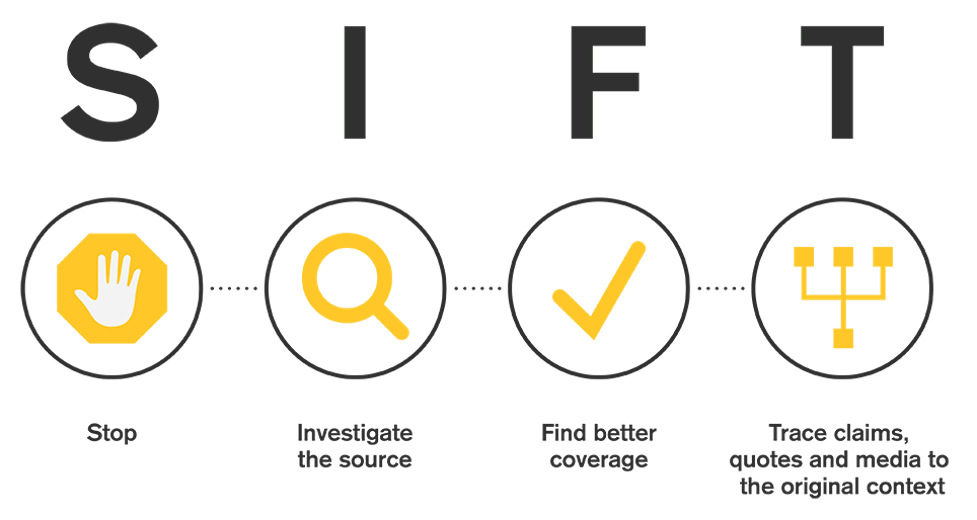54 Spotting Fake News
The term fake news has gained popularity in the last five years. According to Google Trends, Google searches for fake news dramatically increased during the presidential campaign of 2016. Fake news is simply news that is untrue, often shared with the intent to mislead or influence audiences.
The spread of misleading information (or misinformation) is not a new phenomenon. The first recorded instance of misinformation occurred in Rome from 44 to 31 BC when Marc Anthony’s opponent for the role of emperor, Octavian, started a smear campaign with etched coins that ultimately led to the Battle of Actium (Posetti). Today, misinformation has saturated the information landscape and continues to impact our elections, our society, and our everyday lives. The spread of misinformation is serious, but it can be checked. Tre are four steps you can take to identify fake news using SIFT, which stands for stop, investigate the source, find better coverage, and trace claims, quotations, and media to the original context.

Stop.
When you click a link to a webpage or read a post on social media page, stop and ask yourself whether you know the website or source and what the reputation of the source might be across multiple audiences. If the URL is unfamiliar, take a moment to research the background or readership of the source. If you haven’t heard of the source prior to clicking on it, don’t share it until you have more information.
Investigate the source.
Know what you are reading before you read it. How? Research the source! Professional fact checkers quickly and efficiently do this through lateral research, or independently verifying the source. Rather than reading the “About Us” section of a website and relying on whatever potentially misleading information may be presented there, a professional fact checker opens a new tab in their browser and searches for information about the source from other websites. For example, if you come across an article on the American College of Pediatricians webpage, it may be tempting to trust its claims. However, if you dig deeper by doing a search on the organization, you’ll find that the American College of Pediatricians is actually classified as a hate group by the Southern Poverty Law Center. The organization you actually want to trust bears a similar name, the American Academy of Pediatrics, and holds a reputation as a respected and long-established professional organization for pediatricians. Use your research skills to avoid falling into misinformation traps like this one.
Find better coverage.
Just because information exists on a website does not mean it’s reliable. Even news sources have bias and sometimes outright false information. Take a moment to view the Media Bias Chart by Ad Fontes Media to determine the political leanings of some well-known news sources.
Ideally, you should find information that is meant to inform you with accurate facts and evidence rather than persuade you through biased accounts or interpretations. Be wary of articles that make an emotional appeal to the audience or use inflammatory language.
Trace claims, quotes and media to the original context.
Context is everything. Much of the information you encounter has been edited and tailored with specific audiences in mind. Are you getting the whole story? It is hard to know without tracing shared information back to its original source. Advances in technology have made misleading videos, including deepfakes, increasingly difficult to spot. Visit this article from The Washington Post to see just how convincing video manipulation can be.
For more information on the SIFT method, take about 10 minutes and watch the following videos from SIFT method creator, Mike Caulfield:
Online Verification Skills — Video 1: Introductory Video – YouTube
Online Verification Skills — Video 2: Investigate the Source – YouTube
Online Verification Skills — Video 3: Find the Original Source – YouTube
Attributions
“SIFT (The Four Moves),” Mike Caulfield, Hapgood, CC-BY.
“Journalism, Fake News, & Disinformation,” Posetti, J. et. al., UNESCO, CC BY-SA, https://en.unesco.org/sites/default/files/journalism_fake_news_disinformation_print_friendly_0.pdf.
